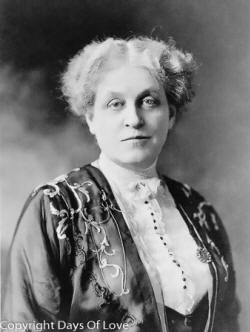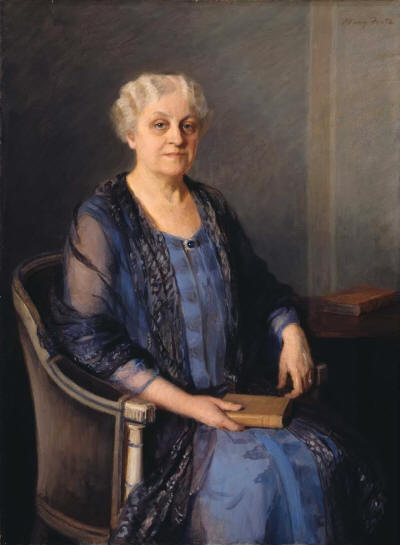

Partner Mary Garrett Hay, buried together
Queer Places:
Iowa State University, Ames, Iowa 50011, Stati Uniti
20 Ryder Rd, Briarcliff Manor, NY 10510, Stati Uniti
120 Paine Ave, New Rochelle, NY 10804, Stati Uniti
257 Central Park West, New York, NY 10024, Stati Uniti
Woodlawn Cemetery, E 233rd St & Webster Avenue, Bronx, NY 10470, Stati Uniti
 Carrie
Chapman Catt (January 9, 1859 – March 9, 1947) was an American women's
suffrage leader who campaigned for the Nineteenth Amendment to the United
States Constitution, which gave U.S. women the right to vote in 1920.[1]
Carrie Chapman Catt, co-founder in 1902 of the IWSA, had two husbands
who predeceased her, but at her request she was buried next to her
friend Mary Garrett Hay.
Their grave in the Bronx, New York, bears the inscription, ‘Here lie
two, united in friendship for 38 years through constant service to a
great cause’. Protestations of love and intimacy hold a key place in
women’s correspondence, both nationally and internationally. ‘My dear,
precious friend’, ‘much love, dearest heart’, wrote Carrie Chapman Catt
to Aletta Jacobs. ‘I love you and I
have admired you from the first day I have met you … With many kisses,’
wrote Jacobs to Catt.
Carrie
Chapman Catt (January 9, 1859 – March 9, 1947) was an American women's
suffrage leader who campaigned for the Nineteenth Amendment to the United
States Constitution, which gave U.S. women the right to vote in 1920.[1]
Carrie Chapman Catt, co-founder in 1902 of the IWSA, had two husbands
who predeceased her, but at her request she was buried next to her
friend Mary Garrett Hay.
Their grave in the Bronx, New York, bears the inscription, ‘Here lie
two, united in friendship for 38 years through constant service to a
great cause’. Protestations of love and intimacy hold a key place in
women’s correspondence, both nationally and internationally. ‘My dear,
precious friend’, ‘much love, dearest heart’, wrote Carrie Chapman Catt
to Aletta Jacobs. ‘I love you and I
have admired you from the first day I have met you … With many kisses,’
wrote Jacobs to Catt.
Catt served as president of the National American Woman Suffrage Association and was the founder of the League of Women Voters and the International Alliance of Women. She "led an army of voteless women in 1919 to pressure Congress to pass the constitutional amendment giving them the right to vote and convinced state legislatures to ratify it in 1920" and "was one of the best-known women in the United States in the first half of the twentieth century and was on all lists of famous American women".[2]
Despite being married twice, Catt did not live with her husband full-time. After the death of George Catt, she lived with Mary "Mollie" Garrett Hay, a suffragist leader from New York.[43] Hay was not a part of the international circle of elites that Catt aligned herself with; however, it was understood that they had a special relationship. Catt requested burial alongside Hay, rather than either of her husbands.[43]

Carrie Chapman Catt and Anna Howard Shaw in 1917

Carrie Chapman Catt by Mary Foote
20 Ryder Rd, Briarcliff Manor, NY 10510, Stati Uniti
120 Paine Ave, New Rochelle, NY 10804, Stati Uniti
In 1915, Anna Howard Shaw resigned as NAWSA president and was replaced by Catt.
When Hay died in 1928, Alda Wilson moved in with Catt and remained as her secretary until Catt's death.[44][45] Wilson was Catt's companion[46] and eventual estate executor, donating six volumes of photographs and memorabilia from Catt's estate to Bryn Mawr College.[47]
On March 9, 1947, Catt died of a heart attack in her home in New Rochelle, New York.[1] She was buried at Woodlawn Cemetery in The Bronx, New York City.[29] alongside her longtime companion, Mary Garrett Hay, a fellow New York state suffragist, with whom she lived for over 20 years.[12][30]
Catt attained recognition for her work both during and after her lifetime. In 1926, she was featured on the cover of Time magazine and, in 1930, she received the Pictorial Review Award for her international disarmament work. In 1941, Catt received the Chi Omega award at the White House from her longtime friend Eleanor Roosevelt.[31] In 1975, Catt became the first inductee into the Iowa Women's Hall of Fame.[29] A stamp was issued in 1948 in remembrance of the Seneca Falls Convention, featuring Catt, Elizabeth Cady Stanton, and Lucretia Mott. In 1982, Catt was inducted into the National Women’s Hall of Fame. In 1992, the Iowa Centennial Memorial Foundation named her one of the ten most important women of the century.[29] The same year, Iowa State University established the Carrie Chapman Catt Center for Women and Politics and in 1992, and the Old Botany building on central campus was renovated and renamed Carrie Chapman Catt Hall in 1995.[29] Catt was played by Anjelica Huston in the 2004 film Iron Jawed Angels. In 2013, she was one of the first four women to be honored on the Iowa Women of Achievement Bridge in Des Moines.[29]
On August 26, 2016 (Women's Equality Day), a monument commissioned by Tennessee Suffrage Monument, Inc.[32] and sculpted by Alan LeQuire was unveiled in Centennial Park in Nashville, featuring depictions of Catt, Anne Dallas Dudley, Abby Crawford Milton, Juno Frankie Pierce, and Sue Shelton White.[33][34]
Alice Paul and Catt both devoted their lives to the women's suffrage movement. They simply had differing opinions on the tactics of raising public and political awareness. Catt believed that the correct method to get womens rights to vote was by a state by state tactic.
My published books: